Broken News
(All the News That's Fit to Reprint)
Bagman Bagged Bartering Birds from a Bag in Bagaces
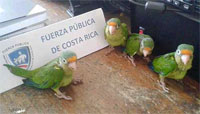 I couldn't dream up these news headlines if I tried. It seems an entrepreneur was walking around with a bunch of young parakeets in a bag, hawking them to whomever would buy. Unfortunately, this is against the law in Costa Rica and the gent was "detained" (detained is a Ticoism for arrested or bagged by the police) on a possible violation of wildlife laws. Of course, the incident just had to happen in the northwestern Costa Rican town of Bagaces, where else.
I couldn't dream up these news headlines if I tried. It seems an entrepreneur was walking around with a bunch of young parakeets in a bag, hawking them to whomever would buy. Unfortunately, this is against the law in Costa Rica and the gent was "detained" (detained is a Ticoism for arrested or bagged by the police) on a possible violation of wildlife laws. Of course, the incident just had to happen in the northwestern Costa Rican town of Bagaces, where else.
Authorities say the parakeet chicks will be returned to the wild. "Tweet" (that's thanks in Parakeet lingo).
Aging is Reportedly Good for Your Health
Continuing with the Ripley's Believe-It-or-Not type headlines, a recent local press report took note of an upcoming (April 10 - I missed an important one again) lecture by a Spanish "expert" (i.e., an "expert" from Spain) entitled: "Envejecer es bueno para la salud" ("Aging is good for your health").
¿Verdad, amigo? (Really?).
Damn, I feel like I missed out on another secret of the universe, and also an opportunity to give opposing testimony. I can't imaging what Señor Experto would have said to prove his point and I'll refrain from asking the obvious question related to expiring.
Semana Santa Stats
Easter week, Semana Santa or Holy Week, is a traditional heavy vacation period for many Ticos. Non-essential government offices (that's most of them) tend to shut down for most of the week and banks for two to three days beginning on Wednesday or Thursday. I was personally aware that the banks weren't operating at peak efficiency during that week when my Social Security check did not get posted to my Banco de Costa Rica account until Monday April 6 even though it routinely, almost religiously, gets deposited on time on the 3rd of the month. Evidently, there was no one at BCR to do the posting this year because it was Good Friday! Silly me, I thought those things happened electronically and automatically.
The Pacific shore is one of the areas to which many in the central valley megalopolis dudes escape during Semana Santa. Thanks to improved infrastructure, particularly the new autopista between San Jose and the coastal road, people from the central valley (known by the Quepos locals as "comehuevos") can get to our area now by car in a little over two hours. So they come in droves, filling the hotels and the beach. GG elects to stay away from the beach for most of the week to avoid the crowds which I find reminiscent of the New Jersey shore in July.. On Thursday night I had to take a bus from the beach at 6 PM, a ride that is normally 15-20 minutes. It took 45 minutes to reach downtown Quepos because traffic was backed up from Pali supermarket in Quepos all the way up the hill to Hotel Plinio, a distance of over a mile. With no traffic light, vehicles moved slowly through the busy Pali intersection. I suspect that this intersection will be the prime candidate for our first traffic light.
 All of this activity each year, of course, results in a spike in violent deaths during the Semana Santa week. The central morgue in Heredia, where all violent and unattended deaths must go by law, reported 82 violent deaths over the week including 20 from traffic accidents, 10 from water-related accidents, 12 murders and 10 suicides. Another 10 deaths were of "natural causes" (so what's a violent natural cause?) and 20 are under investigation for cause.
All of this activity each year, of course, results in a spike in violent deaths during the Semana Santa week. The central morgue in Heredia, where all violent and unattended deaths must go by law, reported 82 violent deaths over the week including 20 from traffic accidents, 10 from water-related accidents, 12 murders and 10 suicides. Another 10 deaths were of "natural causes" (so what's a violent natural cause?) and 20 are under investigation for cause.
On one front the news was positive. Semana Santa is also a time when some celebrators participate in the burning of an effigy of Judas, Jesus' traitor (Quema de Judas). The practice goes back to ancient Europe but often creates fire hazards that keep the bomberos (firemen) and policia quite busy. Police were happy to report that the number of these incidents this year (14) was down considerably and only five people were detained for these incidents compared to 54 last year.
I guess the heat's off Judas for a while (pun intended).
Lutherans Out - Secularists In
The new President of Costa Rica last year raised some eyebrows when he appointed a sitting Lutheran Bishop as his Ministerio de Presidencia (Chief of Staff) - see Catholics Out, Lutherans In. Even though the CR Constitution forbade clerics in such a post, Sr. Solis suggested that it was meant for Catholics only and, surprisingly, the Sala IV Court (constitutional court) went along with his contention. But this past month the headline read: "Insurance Head Moves to Casa Presidencial". Evidently, our Lutheran brother had difficulty working with the folks in the Asamblea (National Legislative Assembly) and Solis felt he had to replace him with a secularist. So Sergio Alfaro Salas, the former head of the national insurance company, known as INS, will take over the position.
Quepos Quickies
-
Last month in Quepos Quickies we reported the intention of the new owner of an iconic name in restauranting here, El Gran Escape, to open soon. We're happy to report that Pablo, the new owner, was true to his word and the restaurant opened in early April. Our ROMEO group pounced on this opportunity to re-review the restaurant and their latest review of El Gran Escape is in the ROMEO section below.
-
Back in December of 2014 the Chronicles reported how three of our most popular locally owned supermarkets, Super 2000, Super Jordix and the Mini-Price Store (PriceSmart) had initiated expansions at the same time (see Super Expansion Fever).
Super 2000 was the first to open its new facility recently. The expanded space is a little weird in that it consists mostly of a raised platform that rings three of the inside walls given the new store a new, larger perimeter but it doesn't offer much of anything new to the buyer; let's wait, maybe there's more to come. Super Jordix has also partially opened its new store and the inside is much brighter and more attractive but again, nothing new in the way of expanded offering. There definitely is more to come there.
Mini-Price
continues to be the one to watch. At this writing it appears to be about a month from opening and is a totally new building five times the size of the old one that will house bakery, fruit & vegetable and meat departments as well as significantly greater grocery space.
¡Pura Vida!
Rumble Talk (Shaky Happenings On or About the Pacific Rim)
Good Friday Tremor
12:33 PM, Friday, April 3, 2015 (Good Friday). There I was, writing effusely and extolling the benefits of papaya, the fruit of the angels, having absolutely no thoughts about burning Judas, when the chair I was sitting in, as well as the floor, walls, and roof began shaking. It only lasted about 7-8 seconds and was not nearly as violent as some Costa Rican tremors GG has experienced before (like the 6.3 - 9 Jan 2009, or the 7.6 - 5 Sep 2012) but, of course, one never knows until it's over.
Sho' nuff, the USGS reported later that the Richter level was only 4.6 but centered near San Isidro, about 20 miles from Quepos as the quetzal flies and that it was shallow, only 8 km (5 miles) deep. Many earthquakes are 30, 40 even 50 km deep; the two mentioned above were 30 and 41 km deep respectively. The closeness and the shallowness of the epicenter of this 4.6R shake is why we felt it so strongly.
Update: Saturday, April 26 saw a similar shake like the one mentioned above; 4.7R, 51 km south-southwest of Golfito (about 45 miles south of Quepos), 12 km deep. Again, shallow and felt.
Turrialba Still Spewing
Meanwhile, Volcan Turrialba continues to be closely watched as it spews ash miles into the atmosphere. On a recent emission Tuesday, April 8, it also started throwing out hot cinders and some lava chunks. Scientists point out that ash can be carried to different locations, sometimes in opposing directions depending on how high up the plume goes. Air stratifies into different levels and can move in opposite directions depending on the height of the layers. During last month's eruption some of the Turrialba ash at ground level moved eastward towards the caribbean but at 8,000 meters the movement took the ash across the central valley, dusting San José in the process, and then to the northwest province of Guanacaste, the Nicoya peninsula and finally into the Pacific.
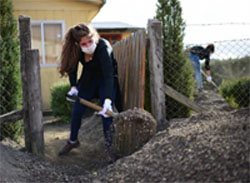 |
Digging Out In Chile |
Turrialba continued to periodically spew ash and smoke throughout the month and on April 23 the two main airports in San José, Juan Santamaria in Alejuela and Tobias Bolaños in Pavas were closed once again for the better part of a day because of ash fallout. Some inbound flights were rerouted to Liberia and Panama and a number of outbound flights were cancelled.
The dusting that Turrialba caused, even with the temporary shutdown of the airports, was nothing compared to the ash spewed out from a major eruption of the Calbuco volcano, some 500 miles south of Santiago, Chile as the ash flies. The photo to the right shows local residents digging out in La Ensenada, a village at the base of the volcano.
Nepal
Just so we don't think all tremors happen on the Pacific Rim, Nepal experienced a nasty earthquake on April 26. It was very powerful at 7.8R (later reduced by USGA to 6.7 although the damage looks more like the higher number), quite shallow at only 15 km deep (9 miles) and happening near the capital city of Kathmandu. Casualty reports the day after put deaths near to 2,000, a figure that had risen to almost 4,000 towards the end of April and which included 18 people who had died in an avalanche on Mount Everest caused by the earthquake. God help the survivors.
Check Out Recent Earthquakes Around the World Posted by the U.S. Geodetic Survey: Today's Quakes |
Super Tsunamis
(Waiting to Surf a Very Large Wave)
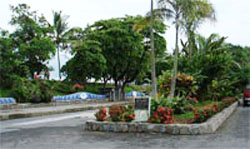 |
Downtown Quepos - Malecón is the Hilly Border to the Left |
 |
Malecón (left) as Seen
from Boca Vieja
(Pez Vela Marina in Background) |
The town of Quepos was originally built under the sponsorship of the United Fruit Co., now Chiquita Corp, in the 1940's. It was accomplished by filling in a swamp with the rubble that resulted from blasting the sides off the two mountains bordering the swamp. The result was an essentially flat town where streets were then arranged in a north-south, east-west grid, very New York like.
To protect the town, which is below sea level, a dyke called the malecón (Spanish for pier or jetty) was constructed at the bay side perimeter of the town. At high tide there appears to be about a 20 foot drop from the top of the malecón to the sea, a distance that would protect the town from most storms but not from a large tsunami. On the town side of the malecón, the drop to street level is more like 10 feet.
 Quepos has a siren type tsunami warning system located near the central fire station, about four blocks from GG's apartment and only one block from the malecón. I've only heard it once some four years ago; I was told later that at that time it was only a test of a new siren (thanks for the clarification amigos, I was seriously considering heading for the hills). It makes the same sound that Londoners heard during the Nazi bombing blitzes (to get that feel from a wailing siren, take a re-look at the movie, Battle of Britain, 1969 starring Trevor Howard, Lawrence Olivier, Christopher Plummer, Suzannah York, Michael Caine, Ralph Richardson, Robert Shaw, Curt Jurgens and a host of others (por dios, they don't make movies with casts like that anymore).
Quepos has a siren type tsunami warning system located near the central fire station, about four blocks from GG's apartment and only one block from the malecón. I've only heard it once some four years ago; I was told later that at that time it was only a test of a new siren (thanks for the clarification amigos, I was seriously considering heading for the hills). It makes the same sound that Londoners heard during the Nazi bombing blitzes (to get that feel from a wailing siren, take a re-look at the movie, Battle of Britain, 1969 starring Trevor Howard, Lawrence Olivier, Christopher Plummer, Suzannah York, Michael Caine, Ralph Richardson, Robert Shaw, Curt Jurgens and a host of others (por dios, they don't make movies with casts like that anymore).
GG has only once in his entire life been at a place when a tsunami warning was actually issued. It was in the town of Puntarenas, Costa Rica on September 5, 2012 about 30 minutes after the second largest earthquake in Costa Rican history (7.6 Richter) hit at an epicenter less than 20 miles away from GG on the Nicoya peninsula (see Terremoto Terror and More on the Big One).
Dozens of us, feeling like the helpless evacuees we were, stood around the Puntarenas Hospital that day watching patients being wheeled out of the emergency room into the streets, IV's dangling. The fear was that the 10-story building would collapse. From inside the hospital when it first hit and where GG experienced the worst of it, it sure felt like collapse was probable. Then word started to spread through the crowd that a Tsunami warning had been issued. The warning was lifted soon after it was issued but we would not know for several hours that it had been lifted shortly after it was issued because the telephone system had gone out of service as a result of the extraordinary volume of calls that were being placed at the time.
 So far we have been talking about tsunamis that are caused by earthquakes. The largest tsunami of this type on record is also one of the more recent; it occurred in December of 2004 in Sumatra, Indonesia as a result of a deep ocean earthquake of 9.1R magnitude. That force is a multiple of about 15 times the energy released in the big Nicoya tremor mentioned above that GG was caught in - personally, after the Puntarenas experience, 9.1 is hard to comprehend).
So far we have been talking about tsunamis that are caused by earthquakes. The largest tsunami of this type on record is also one of the more recent; it occurred in December of 2004 in Sumatra, Indonesia as a result of a deep ocean earthquake of 9.1R magnitude. That force is a multiple of about 15 times the energy released in the big Nicoya tremor mentioned above that GG was caught in - personally, after the Puntarenas experience, 9.1 is hard to comprehend).
The wave was estimated at 50 meters or 165 feet high. As the wave came ashore in Sumatra, it was photographed - the picture is shown in the photo to the left. That tsunami caused approximately 250,000 fatalities all over the world; mostly in Sumatra but also as far away as Africa.
Yet, believe it or not (GG would have made a good front man for Ripley, don't ya think?), much greater tsunamis can be generated by non-earthquake events, by meteor collisions and landslides for example. Archeologists tell us that in North America alone several pre-historic craters exist that were caused by very large meteor collisions. Two of them we now call Chesapeake Bay and the Gulf of Mexico. Some scientists now theorize that a huge tsunami might be a more plausible cause for the extinction of the dinosaurs than the advent of an ice age.
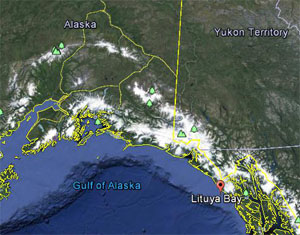 |
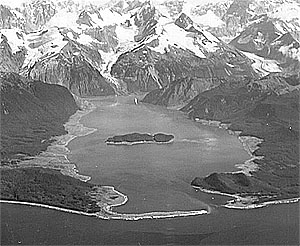 |
Lituya Bay, Alaska |
And evidence of huge historic landslides has been uncovered in several places around the world. In more modern times, in the early 1950's for example, scientists noticed a difference in the tree line at Lituya Bay in Alaska. Very high up the sides of some of the mountains (nearly 500 feet) that surrounded the bay there was a definite band of tree growth which ran from there down to the water's edge and which contained only relatively new growth while the section above this line was the only area that contained old growth. This gave rise to speculation that there had been a major landslide in the area causing a super tsunami that washed away the forest up to the new tree line.
Lituya Bay is on the Gulf of Alaska on the southeast shore. It's a long bay (7 miles long by up to 2 miles wide) and t-shaped at the top. The water depth runs from a maximum of more than 700 feet to only 33 feet at the bay entrance into the Gulf of Alaska. The bay is fed by three glaciers at the top of the bay in an area called the Fairweather Trench, named after the local mountain range, the Fairweather Range. The trench contains a major geological fault and very high and sheer cliffs directly on the water (see photo right).
The scientists in 1953 that postulated the theory of a landslide-caused tsunami at Lituya Bay didn't have long to wait to have their theory confirmed. Five years later, on July 9, 1958, at about 10 PM, a 7.8R earthquake occurred with an epicenter near the head of the bay. This in turn caused a massive fracture and landslide at the face of one of the mountains. A chunk of the mountain a few thousand feet high and amounting to as much as 40,000,000 tons of material slid into the bay in one fell swoop. The resulting tsunami reached a maximum height of 1,740 feet and scoured new trim lines across the bay (those are the white areas in the photo above right). Several boats were sunk and five people killed but one fisherman and his son lived to tell the story of how they were floated in their boat above the forest at the head of the bay before coming to rest in the open sea.
 And then there's the Canary Islands story. The Canaries are a group of Spanish islands off northern Africa. In 2001, a couple of British geologists announced their theory that the west side of the island of La Palma in the Canary Islands is perhaps overdue for a catastrophic collapse and landslide which would cause a huge tsunami. They decided to study the island because its volcano, Cumbre Vieja, had erupted back in 1949 causing a large chunk of its western flank to slip some four meters into the ocean.
And then there's the Canary Islands story. The Canaries are a group of Spanish islands off northern Africa. In 2001, a couple of British geologists announced their theory that the west side of the island of La Palma in the Canary Islands is perhaps overdue for a catastrophic collapse and landslide which would cause a huge tsunami. They decided to study the island because its volcano, Cumbre Vieja, had erupted back in 1949 causing a large chunk of its western flank to slip some four meters into the ocean.
The Brits concluded that the western side of La Palma remains very unstable to this day and that it could slip along a path 25 km wide (15 miles) at any time. If it did so all at once, a mega-tsunami would be created that would fan out cross the Atlantic but still be up to 50 meters high (165 feet) when it hit New York. The devastation would be catastrophic. It would obliterate virtually all the Caribbean islands and ravage shore cities and towns from northern Europe to Newfoundland in Canada all the way down to Recife in Brazil (dude, that includes the caribbean side of Costa Rica).
Of course, not all scientists agree with the conclusions of the British report. In fact some Dutch geologists at the Technical University of Delft have issued a report based on their own studies that says the island is much more stable than the Brits indicated, that the topography and geology does not lend itself to one huge slide but to many as a result of the slide breaking into many separate and smaller slides. Based on their modeling (I hope these weren't the same guys who did the global warming modeling) they couldn't find a scenario that would cause a catastrophic disaster.
Maybe one shouldn't cut off one's vacation plans for the Canaries just yet, but guys, I'm not so sure I would rule out what mother nature wants to do despite your "modeling".
In the meantime we wait and watch, but one rule is obvious: if the water at the beach or in the bay recedes quickly, run like hell the other way!
¡Solo Bueno!
TOP
The Pleasure and Power of Papaya
(Fruit of the Angels)
They are in virtually every corner grocery store, supermarket and verdulería (fresh vegetable and fruit store) in Costa Rica. At your local outdoor fresh market (feria) you'll find huge mounds of them to choose from. Street vendors with hand or horse drawn carts will have them. They are indeed ubiquitous here.
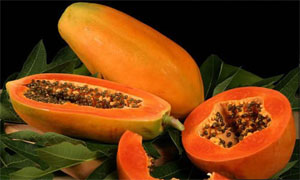 Of course, we're talking about papaya, a fruit that Christopher Columbus called the "fruit of the angels".
Of course, we're talking about papaya, a fruit that Christopher Columbus called the "fruit of the angels".
The taste of papaya has been described by one critic like this: "Deliciously sweet with musky undertones and a soft, butter-like consistency." Yup. Papaya are also one of the easiest tropical fruits to process into edible pieces. A ripe papaya, one that has turned yellow or golden orange on the outside, lends itself to easily cutting off the thin skin from the flesh. You can then halve it and scrape out the seeds, but you might want to save some of the seeds - see health benefits below. GG then chops the flesh into bite sized pieces or wedges.
Unripe or green papayas also offer other interesting cooking adventures or can be used for garnishing but to obtain the sweet, soft fruit described above, they must be allowed to ripen until they've achieved that yellow/orange look on the outside. Papayas ripen best on the tree but also over a few days on the kitchen counter.
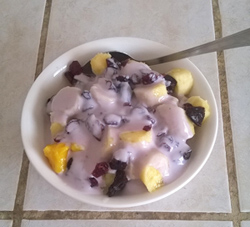 |
A GG Breakfast, With Fresh Papaya, Pineapple, Mango, Banana, Chopped Prunes,
Craisins and Blackberry Yogurt |
Eaten by itself or with a little yogurt or whipped cream, papaya is a sweet, tasty snack (and a healthy one - more below). Combined with other fruits and served as a melange of fruit pieces, it's a treat. Blended or liquefied by itself or with other tropical fruits into a water-based smoothie or into a milkshake, it's delicious and refreshing.
One of GG's standard breakfasts (that means I eat it 2-3 times per week) is a bowl of papaya chunks, pineapple chunks, mango and banana, sprinkled with chopped prunes and or chopped dates, sprinkled further with raisins or craisins (cranberry raisins) and all bathed in plain or fruit flavored liquid yogurt. The picture shown to the right has the papaya as the bottom layer and the liquid yogurt used that morning was mora (blackberry). Outstanding.
Unripe (green) papayas do not have the sweetness of the ripe fruit but contribute a certain tanginess to meals. It's a favorite in some asian cuisines including Thai and can be a common ingredient in Pad Thai or even completely replace the noodles in that dish. Green papaya also has more intensive health benefits than the ripe version (see below).
 |
A Flowering Papaya |
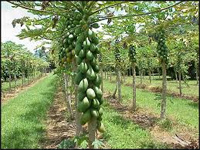 |
Papaya Orchard |
Like money, papayas grow on trees (well at least I got one of those right). The trees grow rapidly, somewhat like bamboo and can easily reach heights of 25 to 30 feet. My landlady got the idea one day to plant a papaya seedling, about two feet tall, in a narrow border area on the side of their villa. I watched it grow from my balcony every day coming in and out of my abode. In a matter of weeks it had tripled in height and after a year it was over the roof line of their villa. When it fruited, we were all treated to a large number of sizeable fruit as her family could not consume it all. Eventually the tree became too high and the roots began to dig into the foundation of their house so it had to be cut down.
There are three types (sexes) of papaya trees, male, female and hermaphrodite (kinda like Manuel Antonio beach). The hermaphrodite version is the main commercial one used as the male produces only pollen, never fruit and the female produces only an inedible fruit. Crossing the male and female is currently the only method of producing the hermaphrodite specie but scientists are working on a self-pollinating version. (I think I've confused that genealogy enough)
Papayas produce prolific quantities of fruit under the canopy at the top of the tree as well as along its trunk. It takes 1-3 years for a seedling to begin fruiting. Worldwide, papaya is the third largest commercially produced tropical fruit after mango and pineapple. A interesting report came out recently that said the current hermaphrodite commercial version, the one that best produces large amounts of sweet, edible fruit, has been traced back to the type which has been historically grown in Guanacaste province in northwestern Costa Rica. The estimate is that growing that version there
goes back as much as 4,000 years (now that's one old feria).
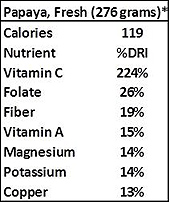 Not only is papaya tasty, it is exceedingly healthful as are virtually all the tropical fruits. The table at right shows the values of important nutrients and vitamins in papaya (DRI = daily recommended intake - I presume). The numbers are based on 276 grams of papaya or a little less than 10 oz, not a difficult amount to consume in one sitting (the article was not clear as to whether the 10 oz. was raw or processed). I typically process whole papaya fruit that weigh up to a kilo or 1,000 grams. The obvious figure that stands out in the table is the very high level of Vitamin C at 224% of recommended daily intake.
Not only is papaya tasty, it is exceedingly healthful as are virtually all the tropical fruits. The table at right shows the values of important nutrients and vitamins in papaya (DRI = daily recommended intake - I presume). The numbers are based on 276 grams of papaya or a little less than 10 oz, not a difficult amount to consume in one sitting (the article was not clear as to whether the 10 oz. was raw or processed). I typically process whole papaya fruit that weigh up to a kilo or 1,000 grams. The obvious figure that stands out in the table is the very high level of Vitamin C at 224% of recommended daily intake.
This is how the George Mateljan Foundation (which describes itself as a not-for-profit foundation with no commercial interests or
advertising) summarizes the health benefit of the fruit:
"Papayas offer not only the luscious taste and sunlit color of the tropics, but are rich sources of antioxidant nutrients such as carotenes, vitamin C and flavonoids; the B vitamins, folate and pantothenic acid; and the minerals, potassium, copper, and magnesium; and fiber. Together, these nutrients promote the health of the cardiovascular system and also provide protection against colon cancer. In addition, papaya contains the digestive enzyme, papain, which is used like bromelain, a similar enzyme found in pineapple, to treat sports injuries, other causes of trauma, and allergies."
The literature points out that green papaya contains even higher quantities of papain than the ripe fruit when ingested raw but that it may lose a good deal of it's nutrient value when cooked.
 And papaya seeds have an even more dramatic affect on some problems. They are reported as an effective treatment for liver cirrhosis, for example. Papaya seeds are not sweet and can be bitter if chewed or ground in any way. But for liver treatment, a half dozen dried seeds are ground up in a pepper grinder, or fresh ones are crushed with a mortar and pestle, then mixed with a tablespoon of fresh lime juice. The mixture is taken twice a day for a month. Many cirrhosis sufferers have had dramatic improvements with this powerful natural remedy.
And papaya seeds have an even more dramatic affect on some problems. They are reported as an effective treatment for liver cirrhosis, for example. Papaya seeds are not sweet and can be bitter if chewed or ground in any way. But for liver treatment, a half dozen dried seeds are ground up in a pepper grinder, or fresh ones are crushed with a mortar and pestle, then mixed with a tablespoon of fresh lime juice. The mixture is taken twice a day for a month. Many cirrhosis sufferers have had dramatic improvements with this powerful natural remedy.
GG had another, but somewhat different experience with papaya seeds. In the early years after moving to Costa Rica I had experienced, two to three times a year, stomach upsets that included diarrhea. This is not an uncommon occurrence here for both locals and visitors. Many blame this condition on "food poisoning" but I continue to think that the problem results from natural bacteria that builds up on fresh farm produce here, like lettuce and celery, that comes directly from the farm to the store and which is unlikely ever washed by the farmer or sufficiently by the food preparer (like me). My feeling is that the bacteria that causes the problem is not friendly to digestive bacteria and overwhelms it.
But whatever the source of the problem, these stomach upsets would plague me for several days. Eventually I complained to a Tico about the problem and she told me to try a few tablespoons of fresh papaya seeds, cautioning me not to chew them as they are bitter. I bought a large, fresh, ripe papaya and scooped out the seeds, treating myself to three heaping tablespoons each day for two days. By the end of the second day the condition was totally relieved. Since then I routinely treat myself, preventatively, to a tablespoon of the seeds every time I clean a new papaya (2-3 times a month) and to this day I have not suffered a return of the stomach problem.
Today I keep papaya on the top of my shopping list both for the delicious flavor and its healthful benefits.
¡Pura Vida!
TOP
Artista del Barrio
(When You Love What You Do)
This story falls into the category of there being seven thousand stories in the naked city (Quepos).
GG was walking home from downtown Quepos one day a couple of months ago and noticed a change in one of his neighbor's houses about one block from his apartment. The house had sprouted several paintings of Costa Rican birds and other animals just inside its front doorway, very bright in color. I stopped for a second to take note and a young man emerged from the house and introduced himself.
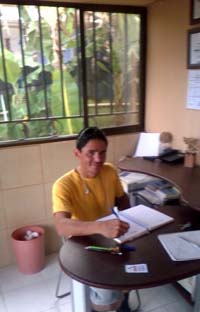 His name is José Fernández and he's an artist, primarily a painter. He had just moved into this house and set up his studio in the front room. The room faces west, has large glass panes in front and provides good lighting throughout the day. A few weeks later I asked José if he would sit for an interview
for the Golden Gringo Chronicles. He smiled at the name and said "Claro" (sure).
His name is José Fernández and he's an artist, primarily a painter. He had just moved into this house and set up his studio in the front room. The room faces west, has large glass panes in front and provides good lighting throughout the day. A few weeks later I asked José if he would sit for an interview
for the Golden Gringo Chronicles. He smiled at the name and said "Claro" (sure).
We met in José's office which is part of his studio. I was immediately impressed with the organization and efficiency of his business arrangement; something I would not necessarily associate with an artist (sometimes I can't get the latent business consultant out of me). We quickly discovered that we spoke the other's native language with less than fluency but we managed to get along in Spanglish, hanging up on only a couple of words.
Prior to his current location, José had lived in Quepos-Manuel Antonio for three years. He is 42
and has a four year old son in Cartago where he came from originally. He spends as much time as he can there with his son and had just come back from a four day visit when we sat down for a talk. José has been an artist about twelve years and has a number of his paintings and murals in well known hotels and restaurants in the area, like the Hotel Parador and Hotel Mariposa. His paintings are also displayed in several galleries in the area including Regalame at Si Como No in Manuel Antonio and Galeria Oskar in Quepos.
 |
José Touching Up a Panel
of One of His Murals |
 José describes his style as "paisjismo" or landscape oriented. He does both paintings and murals that include scenes of local nature and tropical animals, particularly birds.
José describes his style as "paisjismo" or landscape oriented. He does both paintings and murals that include scenes of local nature and tropical animals, particularly birds.
Why do you love being an artist?, asks our reporter. "I love the tranquility of working on my own, some good music in the background; it's like being in the selva (forest), quiet, peaceful". What is your favorite animal? He thought a while, then said with a smile "the Tepezquintle".
A Tepezquintle (also known as a Spotted Paca) is a rodent like animal that lives in the mountains and foothills of southern Mexico, and the Central and South Americas. This is not a house mouse as it ranges in weight from6 to 12 kg (13 to 26 pounds)and our artist friend thinks it's "cute". While hunting them is illegal anymore in Costa Rica (as is hunting any animal here) some are beginning to be raised on farms for consumption and GG had the opportunity of tasting the meat of this rodent a couple of years ago - it was one of the richest meats I have ever tasted, way superior to pork or chicken. When I mentioned this to José, he just smiled.
José is also available for art lessons and currently has both children and adult students. GG is toying with the idea of expanding his horizons by signing up for a few lessons, although I would do so with some trepidation, wondering whether or not all that would emanate from my brush would be in squares and straight lines, the things to be expected from an engineer's brain.
Here's contact information for José:
Galeria Arte 73, José Fernández, pintura artistica & murales
Tel: 506-8636-0727
Email: galeria.arte73@hotmail.com
Welcome to the barrio, amigo José!
TOP
Travel Quote of the Month
What's-in-a-Word
Fruit & Papaya
Ever wonder where the name "fruit" came from? My warped mind did, so I looked it up. It's use was first recorded in Middle English and Old French and came from the Latin fructus, meaning "enjoy' and related to the fruits of the earth at harvest time. But the latin also activated a corroded corner of my memory; "I kept hearing "fructus ventris" and eventually remembered it was part of Gregorian Chant I practiced some 55-60 years ago: Benedícta tu in muliéribus, et benedíctus frúctus véntris túi, Iésus.
The word for papaya was easier, it came from the Spanish experience in South America and the Arawak native language. The Arawak lived in northeastern South America (Venezuela, Guyana, Suriname, and French Guiana). Their word for papaya was papáia. Other Arawak words related to food came from the Spanish experience as well, such as guayaba (guava) and maiz (corn). In addition, a number of non-food words came from this source: canoa (canoe), hamaca (hammock), huracán (hurricane), tabaco (tobacco) and tiburón (shark), to name a few. In Australia, papaya is known as pawpaw, but technically it's a different tree.
Lying in a hamaca strung between two pawpaw trees, drinking a papáia smoothie is part of the basic logo of the Golden Gringo Chronicles (see header photo above) and a good representation of GG's lifestyle.
TOP
ROMEO Corner
(Retired Old Men Eating Out)
El Gran Escape, Quepos
Location: Front Street, Quepos across from the Malecón.
Hours: Breakfast, Lunch and Dinner, Monday through Sunday
Parking: Ample on the streets around the restaurant.
Contact: Tel.: 506- 2777-0395; Website: http://www.elgranescape.com/, Email For Reservations: http://www.elgranescape.com/reservations/
Reviewing ROMEOS: Anita M., Mary M., Lance M., Bob N.
To Review Our Rating System and Procedure, go here: R.O.M.E.O. Rating System
 The ROMEO Group first reviewed (the old) El Gran Escape in March, 2011. We again reviewed it when the restaurant was moved to Pez Vela Marina; see January 2014. The marina version has since been separated from the El Gran Escape name and is now operated as the Runaway Grill.
The ROMEO Group first reviewed (the old) El Gran Escape in March, 2011. We again reviewed it when the restaurant was moved to Pez Vela Marina; see January 2014. The marina version has since been separated from the El Gran Escape name and is now operated as the Runaway Grill.
El Gran Escape is now back in its original location under new management. The picture to the left was actually taken of the original restaurant. It's a bit flattering to the current restaurant because much of the greenery shown was removed during its inactive period. Likewise the dining room is plain with no decorations whatever on table or on the walls. The original restaurant benefited from years of slowly building up its decorations, particularly those that related to the fishing tournaments that were centered there. We caught the new restaurant within a few weeks of its opening and perhaps we need to wait some time to see what motif will evolve; for the time being we have to give it a three sloth rating for atmosphere.
We were presented with brand new glossy menus and GG commented that the number of main course offerings was significantly more limited that in the past. We did not learn until near the end of the meal that we had been presented two different menus. GG and one other ROMEO had gotten the lunch menu with fewer main courses while others got the full dinner menu. The menus were indistinguishable from each other from the outside until a detailed line by line comparison was made of the internal pages.
Thinking himself limited to the menu received, GG ordered a sandwich made up of a tuna steak with cheese and fried onions on whole wheat bread accompanied by french fries. It was quite tasty. Another ordered an appetizer of nachos and still another had a tuna steak with vegetables. All were reported quite tasty, even if the nachos were a little different.
Comments were made that portions were adequate but not as large as the original restaurant where it was common to come away from a dinner there with half the main course in a monkey bag (Costa Rican equivalent of a doggy bag).
For dessert there were three selections and two of us chose a chocolate mousse which actually was a chocolate mouse cake that was very rich and chocolaty. Others had a pineapple and passion fruit flan that was also rich and flavorful. For food, we give El Gran Escape four sloths.
|
 |
|
$$$.5 |
Value Index =
3/3.5x100 = 86 |
Our waiter was an old friend who had worked in a hotel GG frequented for years for breakfast in Manuel Antonio. He was courteous and attentive but a bit hampered by the menu mix up as well as the caja (cashier) staff. Three and a half sloths for service.
 The cashier difficulty occurred when one of our party noticed that she had been charged two times for the chocolate mousse cake. Sure enough, so had GG. The bills were quickly corrected but our lady ROMEO also noticed she had been charged tax on the full menu price when the bottom of the menu stated it was included in the price. That prompted another round of bill adjustments. When the smoke cleared, GG's bill came in at 12,773 colones or about $24 for the tuna steak sandwich., chocolate mousse cake, one coke and one coffee. That puts the cost slightly above average for similar meals here but not on the high end so we give the restaurant three and a half $ for cost. That puts the Value Index at 3/3.5x100 = 86.
The cashier difficulty occurred when one of our party noticed that she had been charged two times for the chocolate mousse cake. Sure enough, so had GG. The bills were quickly corrected but our lady ROMEO also noticed she had been charged tax on the full menu price when the bottom of the menu stated it was included in the price. That prompted another round of bill adjustments. When the smoke cleared, GG's bill came in at 12,773 colones or about $24 for the tuna steak sandwich., chocolate mousse cake, one coke and one coffee. That puts the cost slightly above average for similar meals here but not on the high end so we give the restaurant three and a half $ for cost. That puts the Value Index at 3/3.5x100 = 86.
Experience in operation will eventually restore the original atmosphere, flavor and icon status of the old El Gran Escape.
Golden Gringo Chronicles Novel and E-Books Now Available!
 The story of the Golden Gringo Chronicles is also available as a hard copy novel of 192 pages available through Amazon and all major online retailers. ($9.95)
The story of the Golden Gringo Chronicles is also available as a hard copy novel of 192 pages available through Amazon and all major online retailers. ($9.95)
Amazon link: GGC, the Book. (Kindle Edition available)
Follow GG through the first six years of his odyssey in making the decision to retire in Costa Rica, overcoming the trials and tribulations of moving and obtaining residency there and the fun and experience of actually living in Ticoland.
Ride along with the Golden Gringo as he learns about the rich, varied culture of Costa Rica, the incredible bio diversity, the charming nature of the Costa Rican people and the ease with which a sometimes clueless ex-pat can assimilate into a small southwestern town on the Pacific coast.
Whether you are already a Costa Rican resident, someone contemplating a move here or just a traveler who enjoys different cultures, you will find the Golden Gringo Chronicles interesting, entertaining and informative about Costa Rica.
A narrative version of the Golden Gringo Chronicles is now also available as a trilogy of E-books in formats compatible with virtually all electronic platforms.
Part 1: (FREE!)
Leaving the Homeland
Part 2: ($3.99)
The Early Years
Part 3: ($3.99)
Becoming Tico, Maybe
Click on Part Number above for E-book sample downloads or click the price above right for purchase. (The best price is on Part 1; it's FREE)
Opt-In Here to Receive Your Free Copy Monthly
The Golden Gringo Chronicles is a free newsletter that is non-political, non-commercial and, hopefully, entertaining. By signing up you will receive an email each month around the first of the month giving you the links to the latest edition as well as to each feature and departmental section.
CLICK HERE TO SIGN-UP FOR THE
GOLDEN GRINGO CHRONICLES
or Email me at gg@goldengringo.com
The Golden Gringo
Pura Vida!


 All of this activity each year, of course, results in a spike in violent deaths during the Semana Santa week. The central morgue in Heredia, where all violent and unattended deaths must go by law, reported 82 violent deaths over the week including 20 from traffic accidents, 10 from water-related accidents, 12 murders and 10 suicides. Another 10 deaths were of "natural causes" (so what's a violent natural cause?) and 20 are under investigation for cause.
All of this activity each year, of course, results in a spike in violent deaths during the Semana Santa week. The central morgue in Heredia, where all violent and unattended deaths must go by law, reported 82 violent deaths over the week including 20 from traffic accidents, 10 from water-related accidents, 12 murders and 10 suicides. Another 10 deaths were of "natural causes" (so what's a violent natural cause?) and 20 are under investigation for cause.


 Quepos has a siren type tsunami warning system located near the central fire station, about four blocks from GG's apartment and only one block from the malecón. I've only heard it once some four years ago; I was told later that at that time it was only a test of a new siren (thanks for the clarification amigos, I was seriously considering heading for the hills). It makes the same sound that Londoners heard during the Nazi bombing blitzes (to get that feel from a wailing siren, take a re-look at the movie, Battle of Britain, 1969 starring Trevor Howard, Lawrence Olivier, Christopher Plummer, Suzannah York, Michael Caine, Ralph Richardson, Robert Shaw, Curt Jurgens and a host of others (por dios, they don't make movies with casts like that anymore).
Quepos has a siren type tsunami warning system located near the central fire station, about four blocks from GG's apartment and only one block from the malecón. I've only heard it once some four years ago; I was told later that at that time it was only a test of a new siren (thanks for the clarification amigos, I was seriously considering heading for the hills). It makes the same sound that Londoners heard during the Nazi bombing blitzes (to get that feel from a wailing siren, take a re-look at the movie, Battle of Britain, 1969 starring Trevor Howard, Lawrence Olivier, Christopher Plummer, Suzannah York, Michael Caine, Ralph Richardson, Robert Shaw, Curt Jurgens and a host of others (por dios, they don't make movies with casts like that anymore). So far we have been talking about tsunamis that are caused by earthquakes. The largest tsunami of this type on record is also one of the more recent; it occurred in December of 2004 in Sumatra, Indonesia as a result of a deep ocean earthquake of 9.1R magnitude. That force is a multiple of about 15 times the energy released in the big Nicoya tremor mentioned above that GG was caught in - personally, after the Puntarenas experience, 9.1 is hard to comprehend).
So far we have been talking about tsunamis that are caused by earthquakes. The largest tsunami of this type on record is also one of the more recent; it occurred in December of 2004 in Sumatra, Indonesia as a result of a deep ocean earthquake of 9.1R magnitude. That force is a multiple of about 15 times the energy released in the big Nicoya tremor mentioned above that GG was caught in - personally, after the Puntarenas experience, 9.1 is hard to comprehend). 

 And then there's the Canary Islands story. The Canaries are a group of Spanish islands off northern Africa. In 2001, a couple of British geologists announced their theory that the west side of the island of La Palma in the Canary Islands is perhaps overdue for a catastrophic collapse and landslide which would cause a huge tsunami. They decided to study the island because its volcano, Cumbre Vieja, had erupted back in 1949 causing a large chunk of its western flank to slip some four meters into the ocean.
And then there's the Canary Islands story. The Canaries are a group of Spanish islands off northern Africa. In 2001, a couple of British geologists announced their theory that the west side of the island of La Palma in the Canary Islands is perhaps overdue for a catastrophic collapse and landslide which would cause a huge tsunami. They decided to study the island because its volcano, Cumbre Vieja, had erupted back in 1949 causing a large chunk of its western flank to slip some four meters into the ocean.  Of course, we're talking about papaya, a fruit that Christopher Columbus called the "fruit of the angels".
Of course, we're talking about papaya, a fruit that Christopher Columbus called the "fruit of the angels". 




 His name is José Fernández and he's an artist, primarily a painter. He had just moved into this house and set up his studio in the front room. The room faces west, has large glass panes in front and provides good lighting throughout the day. A few weeks later I asked José if he would sit for an interview
for the Golden Gringo Chronicles. He smiled at the name and said "Claro" (sure).
His name is José Fernández and he's an artist, primarily a painter. He had just moved into this house and set up his studio in the front room. The room faces west, has large glass panes in front and provides good lighting throughout the day. A few weeks later I asked José if he would sit for an interview
for the Golden Gringo Chronicles. He smiled at the name and said "Claro" (sure).
 José describes his style as "paisjismo" or landscape oriented. He does both paintings and murals that include scenes of local nature and tropical animals, particularly birds.
José describes his style as "paisjismo" or landscape oriented. He does both paintings and murals that include scenes of local nature and tropical animals, particularly birds. 
 The ROMEO Group first reviewed (the old) El Gran Escape in
The ROMEO Group first reviewed (the old) El Gran Escape in 
 The cashier difficulty occurred when one of our party noticed that she had been charged two times for the chocolate mousse cake. Sure enough, so had GG. The bills were quickly corrected but our lady ROMEO also noticed she had been charged tax on the full menu price when the bottom of the menu stated it was included in the price. That prompted another round of bill adjustments. When the smoke cleared, GG's bill came in at 12,773 colones or about $24 for the tuna steak sandwich., chocolate mousse cake, one coke and one coffee. That puts the cost slightly above average for similar meals here but not on the high end so we give the restaurant three and a half $ for cost. That puts the Value Index at 3/3.5x100 = 86.
The cashier difficulty occurred when one of our party noticed that she had been charged two times for the chocolate mousse cake. Sure enough, so had GG. The bills were quickly corrected but our lady ROMEO also noticed she had been charged tax on the full menu price when the bottom of the menu stated it was included in the price. That prompted another round of bill adjustments. When the smoke cleared, GG's bill came in at 12,773 colones or about $24 for the tuna steak sandwich., chocolate mousse cake, one coke and one coffee. That puts the cost slightly above average for similar meals here but not on the high end so we give the restaurant three and a half $ for cost. That puts the Value Index at 3/3.5x100 = 86.


